
Armillaria is a genus of fungi that includes the A. mellea species known as honey fungi that live on trees and woody shrubs. It includes about 10 species formerly categorized summarily as A. mellea. Armillarias are long-lived and form the largest living fungi in the world. The largest known organism covers more than 3.4 square miles (8.8 km2) in Oregon's Malheur National Forest and is estimated to be 2,500 years old. Some species of Armillaria display bioluminescence, resulting in foxfire.

Serinus is a genus of small birds in the finch family Fringillidae found in West Asia, Europe and Africa. The birds usually have some yellow in their plumage. The genus was introduced in 1816 by the German naturalist Carl Ludwig Koch. Its name is Neo-Latin for "canary-yellow".

The Agaricales are an order of fungi in the division Basidiomycota. As originally conceived, the order contained all the agarics, but subsequent research has shown that not all agarics are closely related and some belong in other orders, such as the Russulales and Boletales. Furthermore, DNA research has shown that many non-agarics, including some of the clavarioid fungi and gasteroid fungi belong within the Agaricales. The order has 46 extant families, more than 400 genera, and over 25,000 described species, along with six extinct genera known only from the fossil record. Species in the Agaricales range from the familiar Agaricus bisporus and the deadly Amanita virosa to the coral-like Clavaria zollingeri and bracket-like Fistulina hepatica.

Hickory is a common name for trees composing the genus Carya, which includes around 18 species. Five or six species are native to China, Indochina, and India (Assam), as many as twelve are native to the United States, four are found in Mexico, and two to four are native to Canada. A number of hickory species are used for products like edible nuts or wood.

The Strophariaceae are a family of fungi in the order Agaricales. Under an older classification, the family covered 18 genera and 1316 species. The species of Strophariaceae have red-brown to dark brown spore prints, while the spores themselves are smooth and have an apical germ pore. These agarics are also characterized by having a cutis-type pileipellis. Ecologically, all species in this group are saprotrophs, growing on various kinds of decaying organic matter. The family was circumscribed in 1946 by mycologists Rolf Singer and Alexander H. Smith.

The Marasmiaceae are a family of fungi in the order Agaricales. Basidiocarps are most frequently agarics, but occasionally cyphelloid. According to a 2008 estimate, the family contained 54 genera and 1590 species, but recent molecular research, based on cladistic analysis of DNA sequences, has led to a more restricted family concept so that the Marasmiaceae now includes just 13 genera and some 1205 species.

"J'aime la vie" was the winning song of the Eurovision Song Contest 1986, performed for Belgium by Sandra Kim. Belgium had finished the 1985 contest in last place, and thus achieved the rare turnaround from last to first in the space of one year. The song also marks the only time to date that Belgium has won the contest. The song was also included on Kim's album J'aime la vie in 1986. When released as a single, it topped Belgium's singles chart for seven weeks and was the country's best-selling hit of 1986, and it also reached the top 20 in Austria, the Netherlands, Portugal, and Sweden.

Barychelidae, also known as brushed trapdoor spiders, is a spider family with about 300 species in 42 genera.
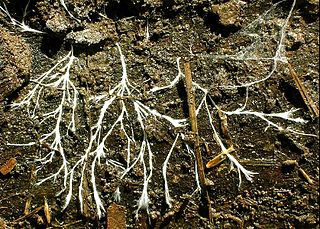
Mycelial cords are linear aggregations of parallel-oriented hyphae. The mature cords are composed of wide, empty vessel hyphae surrounded by narrower sheathing hyphae. Cords may look similar to plant roots, and also frequently have similar functions; hence they are also called rhizomorphs. As well as growing underground or on the surface of trees and other plants, some fungi make mycelial cords which hang in the air from vegetation.
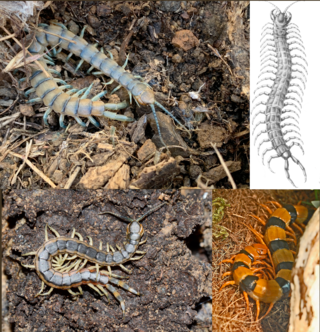
Scolopendra is a species-rich genus of large tropical centipedes of the family Scolopendridae.

The Hymenogastraceae is a family of fungi in the order Agaricales with both agaric and false-truffle shaped fruitbodies. Formerly, prior to molecular analyses, the family was restricted to the false-truffle genera. The mushroom genus Psilocybe in the Hymenogastraceae is now restricted to the hallucinogenic species while nonhallucinogenic former species are largely in the genus Deconica classified in the Strophariaceae.
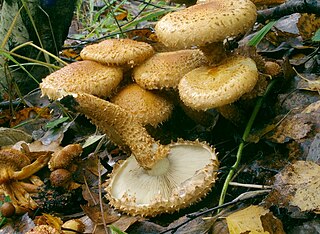
Pholiota is a genus of small to medium-sized, fleshy mushrooms in the family Strophariaceae. They are saprobes that typically live on wood. The genus has a widespread distribution, especially in temperate regions, and contains about 150 species.

The Physalacriaceae are a family of fungi in the order Agaricales. Species in the family have a widespread distribution, ranging from the Arctic, (Rhizomarasmius), to the tropics, e.g. Gloiocephala, and from marine sites (Mycaureola) and fresh waters (Gloiocephala) to semiarid forests (Xerula).
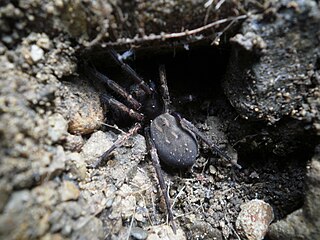
Uliodon is a genus of spiders endemic to New Zealand and possibly Australia. They are commonly referred to as vagrant spiders. Vagrant spiders vary in colour from dark brown to almost black, they typically have a body length of 20mm and a 50mm leg span. When alive, the interior of the male's pedipalp are brightly coloured.

Brunneocorticium is a genus of fungi which following DNA analysis has been placed in the family Omphalotaceae. The genus, described in 2007, contains two corticioid species and one species which does not seem to have any fruiting body.
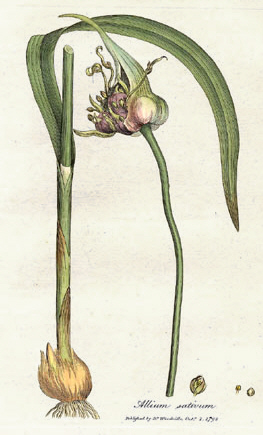
Allium is a genus of monocotyledonous flowering plants with hundreds of species, including the cultivated onion, garlic, scallion, shallot, leek, and chives. The generic name Allium is the Latin word for garlic, and the type species for the genus is Allium sativum which means "cultivated garlic".
Eotaphrosphys is an extinct genus of bothremydid pleurodiran turtle that was discovered in the Mont Aime Formation, France. Originally assigned to the genus "Tretosternum", it consists exclusively of type species E. ambiguum.

Mindomys is a genus of sigmodontine rodents in the family Cricetidae. It includes two species known only from Ecuador, Hammond's rice rat and the Kutukú rat.

















